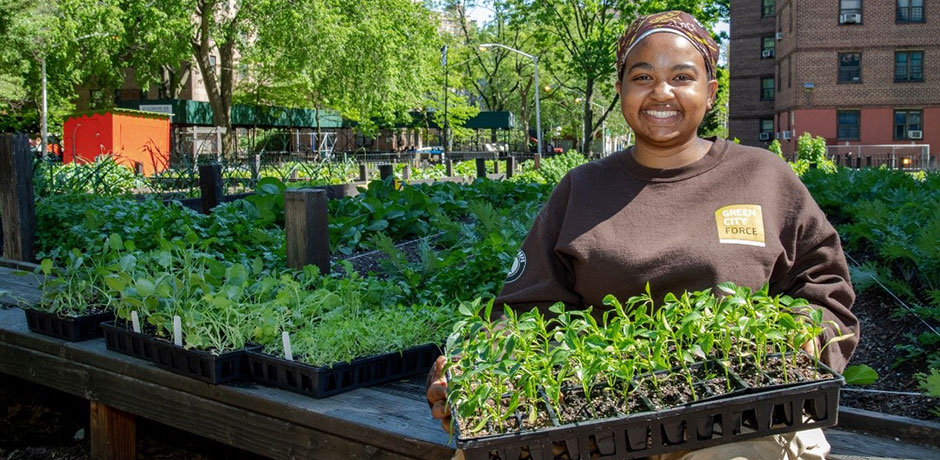Some Ideas on City Blooming You Need To Know
Some Ideas on City Blooming You Need To Know
Blog Article
The 10-Second Trick For City Blooming
Table of ContentsExcitement About City BloomingThe smart Trick of City Blooming That Nobody is Talking AboutThe City Blooming StatementsWhat Does City Blooming Mean?City Blooming Can Be Fun For Everyone
Intrigued in growing food available in the City of Chicago? Considering beginning a neighborhood yard? Adjustments to the Chicago Zoning Ordinance permit agricultural uses like community gardens and metropolitan farms in numerous parts of the city. Below is a checklist of frequently asked concerns pertaining to the guidelines and regulations that farmers ought to take into consideration when intending a metropolitan agriculture task.
The zoning modification does not change any other codes handling composting, structure licenses, acquiring or leasing City owned home, organization licenses or environmental contamination. There are existing codes that manage these problems and they continue to be in complete impact and may apply to your task. Area yards are usually owned or managed by public entities, civic organizations or community-based companies and preserved by volunteers.
Urban farms grow food that is intended to be sold, either on a nonprofit or for-profit basis. Because of their industrial function, urban farms call for a company permit. Yes. An area yard is permitted to offer excess produce that was expanded on site if the sales are accessory or subordinate to the yard's key purpose described over.
Fascination About City Blooming
Composting is permitted yet only for plant material that is produced and utilized on website. The amount of garden compost material can not go beyond 25 cubic lawns at any offered time according to the standards in 7-28-715 of the City's Municipal Code. Yes. Due to the fact that the dirt at many new yard websites needs changing, garden compost, soil, timber chips, or various other products can be acquired to create or enhance the growing area - balcony and patio garden design.

If a structure license is needed then the hoophouse will be taken into consideration an accessory building. You can learn even more about the building permit needs by calling the Division of Buildings. The 25,000-square-foot dimension limit is meant to prevent a single community garden from dominating a given block or interfering with the block's existing property or business personality.
The restriction does not put on yards situated in Public Open Space (POS) districts. Can there be greater than one area garden that is 25,000 square feet on a single block? Yes. The size limitation uses to individual yards, not to individual blocks. No. Fencing is not needed, nonetheless, gardens that have big auto parking locations may be required to install secure fencing or various other landscaping attributes.
Our City Blooming Statements
B1 & B2 districts call for that all industrial usage activities be conducted inside your home. Is fencing required for urban ranches? Fences may be needed, along with landscape design and testing, for certain car park areas and exterior job or storage space areas depending on area and the specific task taking area.
Urban farms call for structure permits and zoning approvals prior to construction (balcony and patio garden design). Various other forms of city evaluation might be called for depending on certain frameworks, activities, dimension, landscape design, licensing, public heath and stormwater monitoring problems.
The Department of Service Affairs and Customer Security can assist determine the particular type of service certificate that's called for. Off street vehicle parking is required for the majority of industrial projects in Chicago. The needed number of car parking rooms is based on the number of staff members working on site and not the square video footage of the growing area.
Excitement About City Blooming

An urban ranch can market garden compost material produced on website, nevertheless, the operation must abide with the regulations in 7-28-715 of the Chicago Municipal Code. Aquaponic systems are permitted indoors on metropolitan ranches in several zoning areas.
Up to five hives or swarms of this link honey may be kept as an accessory usage. Beekeepers have to sign up with the Illinois Department of Agriculture. For additional information regarding the proposed zoning modification you may speak to the Division of Housing and Economic Growth, Bureau of Planning and Zoning at 312.744.8563.
Farming in cities and urban areas An urban farm in Chicago. Urban farming refers to different techniques of cultivating. http://peterjackson.mee.nu/where_i_work#c2252, handling, and dispersing food in city areas. The term additionally relates to the location tasks of pet husbandry, aquaculture, beekeeping, and horticulture in a metropolitan context. Urban agriculture is differentiated from peri-urban farming, which happens in backwoods beside suburbs.
The Ultimate Guide To City Blooming
, that look for to create social networks founded on a common values of nature and neighborhood holism. These networks can establish by way of formal institutional assistance, becoming integrated right into regional community preparation as a "change community" motion for sustainable metropolitan growth.
Some of the initial evidence of city agriculture comes from Mesopotamia.
Report this page